A Guide to the Welfare System in the UK – Chapter 7 Part II
There are many disability benefits available in the UK. If you’re finding it hard to know which disability benefits you are eligible for and how to claim them, then you need to read this, your ultimate disability benefits guide.
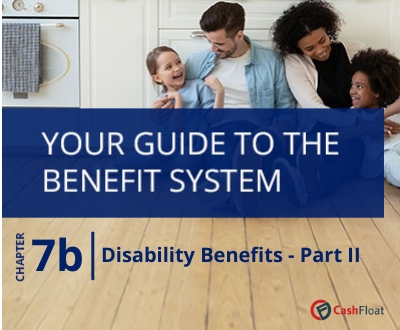
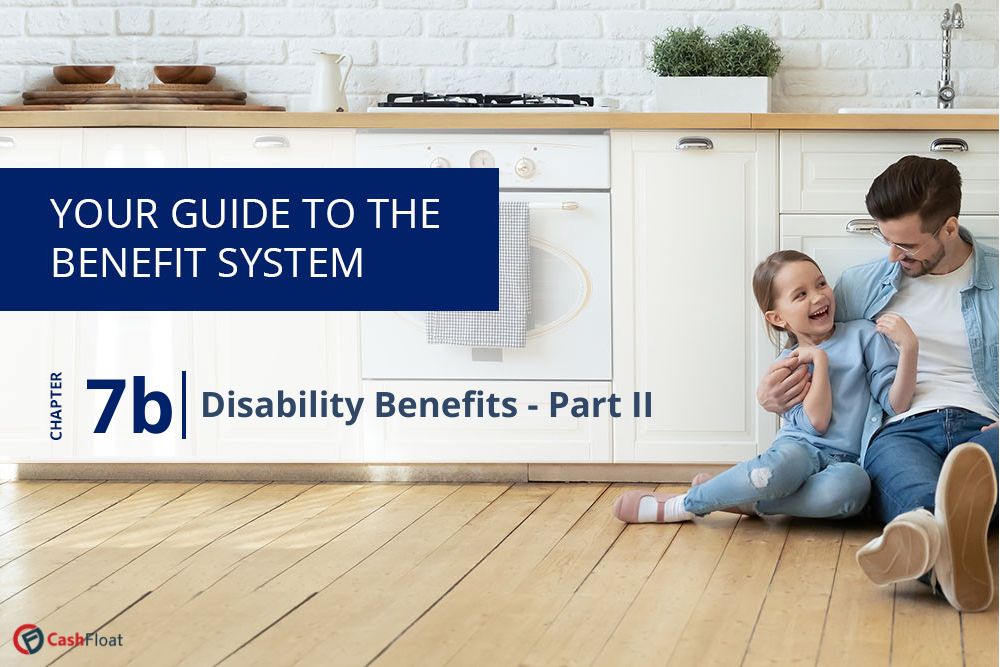
You can read the first part of our chapter about disability benefits in the UK here. It discusses Employment & Support Allowance, Personal Independence Payment, Attendance Allowance and Universal Credit. These are the main benefits available to disabled adults in the UK. It also discusses many of the common supplementary types of support that most disabled people in the UK can receive.
This section (part II of our disability benefits chapter), discusses Carer’s Allowance, Disability Living Allowance, Industrial Injuries Disablement Benefit, Constant Attendance Allowance, the Armed Forces Compensation Scheme and the War Pension Scheme, Blind Person’s Allowance and some other relevant benefits. These are more specific disability benefits, which are only available to certain people. This includes; carers, parents of disabled children, people who received an injury at work, veterans, and blind people. If you think you may be eligible for any of these benefits then read on to find out more.
- Carer’s Allowance is £67.25 per week for someone who cares for another person for over 35 hours a week.
- Parents of children under the age of 16, who suffer from an illness or disability, may be entitled to receive Disability Living Allowance. Many parents don’t realise that they can get this benefit. Read our section on this to find out more.
If you have a disability, mobility issues or an illness that means you require help, you are eligible for disability benefits in the UK. You may also be eligible for disability benefits in the UK if you have a work related illness, if you care for a disabled child, if you care for a disabled adult, if you were injured or made ill through service with the armed forces or if you are blind. You shouldn’t borrow from pay-day loan companies if you can just take a little extra time and get the benefits you are entitled to completely free of charge.
In this chapter, we will be looking at the eligibility requirements, payment amounts and ways to claim some of the other benefits for people with disabilities and for people who look after them.
Carer’s Allowance
- To qualify for Carer’s Allowance, you must look after someone for at least 35 hours a week.
- The person you are caring for does not have to live with you or be your relative.
- If you claim for Carer’s Allowance, it may have an effect on any other benefits you and the person you are looking after receive.
- The person who receives Carer’s Allowance will automatically get National Insurance Credits and may become entitled to other benefits, such as Universal Credit. Normally for these people the total amount of benefits that can claim will go up or stay the same.
- The person being cared for may lose their entitlement to some benefits that they are already receiving.
- You can apply for Carer’s Allowance online. You will have to supply all your details as well as the details of the person you are caring for.
To qualify for Carer’s Allowance, you must care for someone at least 35 hours a week. You will not receive an extra allowance if you care for more than one person. Additionally, only one person can claim Carer’s Allowance for someone who is being cared for. The person you look after does not have to be your relative, nor do you have to be living with them. You’ll receive payment either weekly in advance or every 4 and the allowance is paid straight into your bank account. The person who receives Carer’s Allowance will automatically get National Insurance credits, which will help towards their pension. They may also be able to apply for other benefits, such as Council Tax Reduction, Pension Credit or Universal Credit.
Eligibility Requirements for Carer’s Allowance
To qualify for carer’s allowance, the person you look after must already get one of the following:
- Personal Independence Payment (‘daily living’ component).
- Disability Living Allowance (middle or highest care rate).
- Attendance Allowance.
- Constant Attendance Allowance ( at/above normal maximum rate with Industrial Injuries Disablement Benefit).
- Constant Attendance Allowance (at basic rate with War Disablement Pension).
- Armed Forces Independence Payment.
To be eligible for Carers Allowance, you must:
- Be over 16.
- Care for the person for at least 35 hours a week.
- Have been in England, Scotland or Wales for at least 2 of the last 3 years.
- Normally live in England, Scotland or Wales (with some exceptions) and not be subject to immigration control.
- Not be in full-time education or studying for 21 hours or more per week.
- Earn no more than £128 per after tax, National Insurance and expenses.
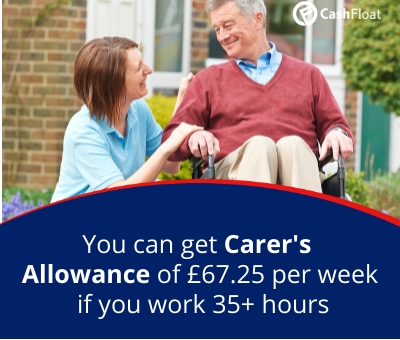
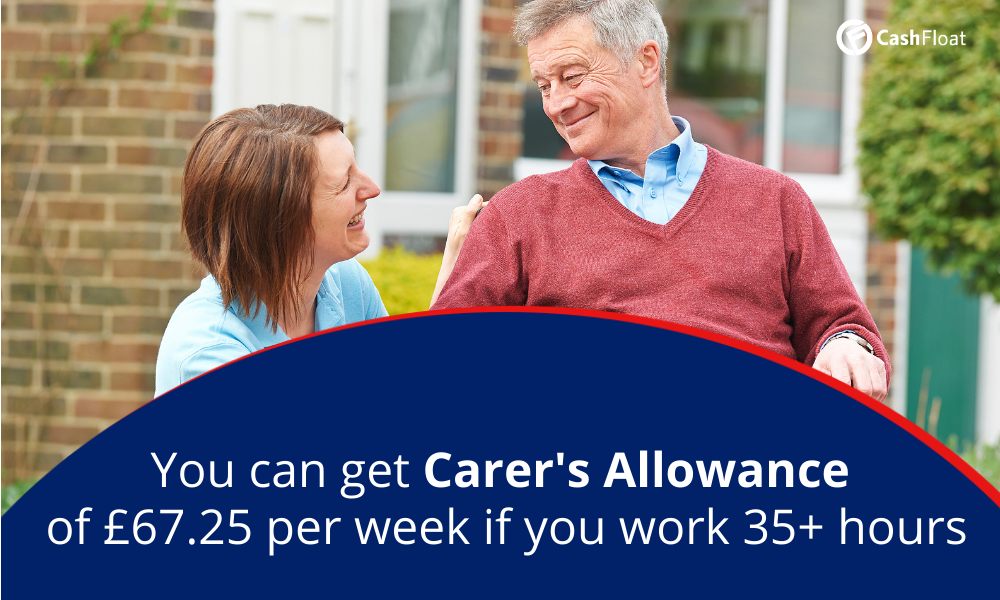
What Effect does Carer’s Allowance have on other Benefits?
Claiming Carer’s Allowance often has an effect on other benefits that the carer/ disabled person can receive.
Effect on the Benefits of the Person being Cared forThe person being cared for will stop getting a severe disability premium paid with any other benefits that they get and the extra amount for severe disability, if they receive that with their pension. On top of this, if they have reduced Council Tax, they may also stop getting that.
Effect on the Benefits of the CarerFor the carer, If they receive other benefits, normally the total amount, in benefits, that they can receive will stay the same or go up. If you apply to receive Carer’s Allowance and you receive Child Tax Credit or Working Tax Credit, it is important that you inform HM Revenue and Customs as this can have an effect on your payments.
The person receiving Carer’s Allowance payments will automatically qualify for National Insurance credits and they may also be able to apply for other benefits.
What other benefits may I get if I Receive Carer’s Allowance?- Local council support. You may be able to take a carer’s assessment and receive extra support, such as free gym membership or relief care from your local council.
- Universal Credit.
- A reduction in your Council Tax.
- Pension Credit, if you’re over the state pension age.
- Grants and bursaries to pay for courses and training.
- People in Scotland may also be able to get the Carer’s Allowance Supplement.
You can use a benefits calculator to see what effect receiving Carer’s Allowance will have on any other benefits that you receive.
How To Claim Carer’s Allowance
Before you apply for Carer’s Allowance, you should have details of the person you are caring for: their date of birth, address and National Insurance number if they’re over 16 and their Disability Living Allowance Reference number if they are under 16. / Disability Living Allowance reference number.
You should have your own National Insurance number as well as that of your partner (if you have one) and your bank or building society account details. If you are studying or working, you should also have your employment details or your course details. Also, you should have your latest payslip or your P45 and details of any expenses that you have, such as pension contributions or the cost of caring for your children.
You can apply for Carer’s Allowance online or by downloading and posting the Carer’s Allowance claim form. Your claim can be backdated by three months.
If your application for Carer’s Allowance is unsuccessful, you can appeal the decision. Once you are working as a carer, you should inform the Carer’s Allowance Unit at the Department for Work and Pensions if your circumstances change, for example, if you get a job, take a break or stop being a carer. If the person you are looking after dies, you should inform the ‘Tell Us Once’ Service.
Is the Carer’s Allowance tax-free?
No, unlike other benefits, you are taxed on the Carer’s Allowance if your earnings go over your tax-free Personal Allowance. The standard tax-free Personal Allowance is £12,500 per year. Most people do not pay any tax on the first £12,500 that they earn in a year.
If I take a holiday, will I still get my Carer’s Allowance?
Yes, if you or the person you are looking after go on holiday, you will still be paid (for up to 4 weeks in every 26 weeks that you receive Carer’s Allowance.) You will also receive the allowance if either of you goes into hospital for up to 12 weeks. Furthermore, you can continue to receive payments for various other reasons where you spend less than 35 hours a week caring for the person. This is considered as ‘taking a break’, however, you should inform the Department for Work and Pensions of your change in circumstances.
Disability Living Allowance For Children Under 16
- Disability Living Allowance is a benefit paid to help with any extra care needed to look after a child under 16 who has a disability.
- The claimant does not have to be the child’s parent, but needs to look after them as if they are the parent.
- They assess claims for Disability Living Allowance in 2 parts: a ‘care’ part and a ‘mobility’ part and payments are made accordingly. Claimants may receive payments for one or both parts.
- The amount that you can receive in Disability Living Allowance depends on the needs of the child and is between £23.60 and £151.40 per week.
- Once a child who receives Disability Living Allowance turns 16, they switch to Personal Independence Payment instead.
The Disability Living Allowance is a sum of money which is paid to help look after a child under the age of 16 who has a disability or a health condition. Their disability or health condition should mean that they need more care than a child of their age normally would or that they have difficulty moving around. Often, parents don’t realise that they can get Disability Living Allowance when they are. Payments can be made for children with a wide range of physical disabilities, illnesses, behavioural conditions, mental health conditions, learning difficulties or developmental delay conditions. The child must have had their condition for at least 3 months and you expect it to last 6 months or more.
The claimant does not have to be the child’s parent but should, at least, be acting in the role of a parent, regarding their day-to-day care. They can also be in work or unemployed. Any other benefits that you receive, any income that you receive or any money that you have in savings will not be taken into account in your application. If you get Disability Living Allowance for a child under the age of 16, you may become entitled to other benefits or an increase in any benefits that you already receive.
There are two components to the allowance that is given and the amount received depends on the level of help which the child needs. There is a ‘Care’ component and a ‘Mobility’ component and each component has higher and lower rates, depending on the needs of the child. You could be awarded either one or both components depending on the child’s condition. Their condition will further decide the rate you are given for each component. The allowance is paid every four weeks into a bank account and is tax-free.

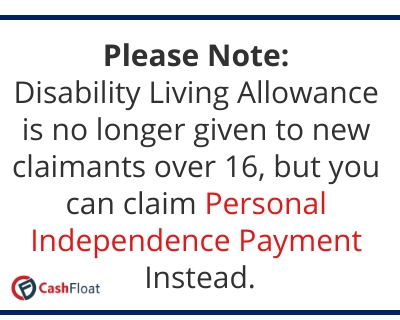
Eligibility Requirements for Disability Living Allowance
To be eligible, the child must:
- Be under 16.
- Need extra looking after compared to a child of their age, and/or have difficulties with movement.
- Have had their health condition or disability for at least 3 months and it should be expected to last at least 6 months more. If they are terminally ill (not expected to live more than 6 months) then they won’t need to have had their condition for 3 months already and there is a fast-track process available.
- Be in Great Britain, The European Economic Area or Switzerland when you claim (with some exceptions).
- Have lived in Great Britain for 6 of the last 12 months if the child is 3 years or over. There are different rules for children under the age of 3.
How To Claim Disability Living Allowance
You can download the Disability Living Allowance form online or call the Disability Living Allowance helpline on 0800 121 4600 and ask for it. In Northern Ireland the process is slightly different. Your claim cannot be back-dated, and it will begin from the date you get the form or from the date you phone (if you return the claim form within six weeks.) The application normally takes about 40 working days to process.
As part of the application, you will need to provide information about the child’s disability or health condition. It may be a good idea to make records of what you have done to care for the child in the weeks building up to your application and use these records as evidence for your claim.
Do I need a Health Assessment for Disability Living Allowance?
Depending on the child’s condition, you may be asked to attend a face-to-face assessment with an independent healthcare professional from the Health Assessment Advisory Service. The HAAS will notify you by letter and tell why the assessment is necessary and where you should go to receive it. You will also be told which paperwork you should bring with you (for both you and the child.)
If you are unhappy with the result of the assessment, you can challenge it. If your challenge is unsuccessful, you can appeal to the Social Security & Child Support Tribunal.
How the ‘Care’ and ‘Mobility’ Components are Assessed and how much you can Receive
In deciding, how much you will receive for your claim the needs of the child will be assessed according to how much care they need (this will decide how much you receive under the ‘care’ component) and how mobile they are (this will decide how much they can receive under the ‘mobility’ component). There are different rates according to the needs of the child. For the ‘care’ component there is a lowest, middle and highest rate, and for the ‘mobility’ component, there is a lower and higher rate.
For each component that the child qualifies for, you will receive the rate relevant to the amount of assistance that they need, as the table below demonstrates.
| How much Disability Living Allowance will I Receive? | ||
|---|---|---|
| Care Component: | Amount of General Care that the Child Requires | |
| Lowest | £23.60 | Help for some of the day |
| Middle | £59.70 | Frequent help or constant supervision during either the day or the night. Or if they get renal dialysis twice a week or more |
| Highest | £89.15 | Help or supervision throughout both day and night, or if they are terminally ill |
| Mobility Component: | Amount of Help that the Child Needs with Mobility | |
| Lower | £23.60 | They are able to walk, but need help or supervision when outside |
| Higher | £62.25 | They are unable to walk, cannot walk more than a short distance without severe discomfort or could become very ill if they try to walk. Or, if they are blind or severely sight impaired. |
Disability Living Allowance After the Age of 16
Until relatively recently, Disability Living Allowance was available to adults, as well as children. For adults, Personal Independence Payment was introduced as an alternative in 2012.
Disability Living Allowance is now only given to new claimants under the age of 16. Therefore, once the child turns 16 you will have to apply for Personal Independence Payment instead. You should receive a letter 20 weeks before the claim for Disability Living Allowance ends or shortly after the child’s 16th birthday explaining how to switch to Personal Independence Payment. The letter will contain a deadline; unless you apply before the date given, payments will stop. If you submit your application in time, you’ll continue receiving Disability Living Allowance until the child begins to receive PIP.
What About Adults who Still Receive Disability Living Allowance?As of the end of 2020, there were still hundreds of thousands of adults in the UK who were still receiving Disability Living Allowance. This is because the government is gradually moving people over to Personal Independence Payment. If you still receive Disability Living Allowance, you will continue to do so until the government tells you that your claim will end. When you are informed that your claim for Disability Living Allowance will end, you will be told how to apply for Personal Independence Payment instead.
For a child who is under 3, what are the rules regarding being a habitual resident of Great Britain and being eligible for Disability Living Allowance?
If a child is under six months, they must have lived in Great Britain for at least 13 weeks. If the child is between the ages of 6 months and 3 years, they must have spent 26 of the previous 156 weeks residing in Great Britain. The rules on residency for a child under the age of 3 do not apply if they are terminally ill.
Can a child with a terminal illness receive Disability Living Allowance?
Yes, if medically the child is not expected to live longer than six months, the application procedure is much faster. You can complete the application form and send it with a DS1500 medical condition report, which you can get from your doctor or another healthcare professional.
The Industrial Injuries Disablement Benefit (IIDB)
- You might be eligible for Industrial Injuries Disablement Benefit if you have a work-related injury or disease which occurred in England, Scotland or Wales.
- You’ll normally have to undergo a medical assessment to judge the extent of your disability or illness. You will be judged on a scale of 1% -100%
- If you are judged to have over 14% disability, you are eligible for at least some support. While if you have 100% disability, you will get the maximum support and will also automatically receive Constant Attendance Allowance (CAA).
- Depending on the results of your assessment, you may also be able to receive Exceptionally Severe Disablement Allowance, Reduced Earnings Allowance (only if your illness or disability began before 1st October 1990), compensation under the Pneumoconiosis, etc (Worker’s Compensation) Act 1979 or the diffuse mesothelioma payment.
You may be eligible for Industrial Injuries Disablement Benefit (IIDB) if an accident or disease, which occurred at work or in an approved employment training scheme or course, caused you injury or made you ill. The injury (or disease) must also have occurred in England, Scotland or Wales. The process is slightly different in Northern Ireland. The amount you receive depends on your circumstances and on the results of an assessment by a medical advisor.
Many people who are eligible to receive IIDB do not realise that they are. The benefit covers many types of injury and disability and, also, covers a wide range of diseases. Among other things, you can receive the benefit if you suffer from chronic obstructive pulmonary disease (COPD), deafness, vibration white finger or asthma as a result of work. It also covers asbestos related diseases, including asbestosis and mesothelioma.
A full list of work related diseases is available from the IIDB Centre.
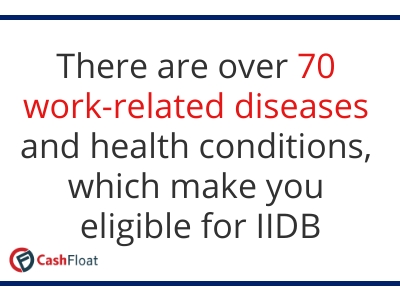

How To Claim Industrial Injuries Disablement Benefit
You can download and print the form: BI 100A (for accidents) or BI 100PD (for diseases), which you will need to return in the post. Alternatively, you can ask the Barnsley IIDB Centre to send you a form. They can be contacted on 0800 121 8379.
Industrial Injuries Disablement Benefit Assessment & Payments
After an assessment by a medical advisor, you will be given a score on a scale of 1%-100%. If you are assessed as over 14%, you are eligible for IIDB. The following amounts are given as a guideline only.
| Level of Disability & Weekly Payment amounts | |
|---|---|
| 100% | £182.00 |
| 80% | £145.60 |
| 60% | £109.20 |
| 40% | £72.80 |
| 20% | £36.40 |
You should notify the IIDB Centre of any changes in your circumstances such as an improvement in your condition. If your disability is assessed as 100%, you can also receive Constant Attendance Allowance.
What Effect will Claiming IIDB have on Other Benefits?
If you are entitled to Industrial Injuries Disablement Benefit, you may also be able to get to other benefits. If your disability is assessed as 100%, you will usually automatically receive Constant Attendance Allowance. Once you get Constant Attendance Allowance, you will be able to receive £72.80 on top of the normal rates for exceptionally severe disablement allowance. Besides Constant Attendance Allowance, people who qualify for IIDB may be able to receive Reduced Earnings Allowance, compensation under the Pneumoconiosis etc. (Worker’s Compensation) Act 1979 or the diffuse mesothelioma payment.
People who are already claiming other benefits may find that making a new claim for IIDB has an effect on their other benefits. For a full list of the other benefits that it can have an effect on, visit the gov.uk website.
Constant Attendance Allowance
If you receive Industrial Injuries Disablement Benefit or a War Disablement Pension and your condition requires daily care and attention, then you will be eligible for Constant Attendance Allowance. The amount you receive depends on the extent of your disability and how much care you need.
In order to receive Constant Attendance Allowance, you must already be receiving Industrial Injuries Disablement Benefit or a war disablement pension. For IIDB, your medical assessment must have judged you as having a 100% disability while those with war disablement should have a disability and receive a war pension of 80% or more.
| How much Constant Attendance Allowance will I receive? | |
|---|---|
| Exceptional rate | £145.60 |
| Intermediate rate | £109.20 |
| Full day rate | £72.80 |
| Part day rate | £36.40 |
How To Claim Constant Attendance Allowance
For industrial injury cases, your entitlement to Constant Attendance Allowance will automatically be considered when you have your medical assessment for Industrial Injuries Disablement Benefit. Normally, you will have to be classed as 100% disabled under IIDB to be eligible for Constant Attendance Allowance.
For those on a war pension, if you believe that you may be entitled to Constant Attendance Allowance, you should download the claim form WPA 0003CAA and send in a postal application. If you are unable to download the form, you can contact Veterans UK at veterans-uk@mod.gov.uk. Alternatively, you can call; 0808 1914 218 and they will be able to provide you with one.
What is a War Disablement Pension?
The War Pension Scheme provides war disablement pensions and lump sum payments to members of the armed forces who suffered illness or injury as a result of their service before 6th April 2005. For people who suffered similar illnesses or injuries after that date, compensation is provided by the Armed Forces Compensation Scheme.
War pensions are provided to people who suffer disablement of at least 20% during active service. Lump sums are provided as single payments for specific types of illness or injury. For complete information on what people can receive, visit the gov.uk website.
The Armed Forces Compensation Scheme
The Armed Forces Compensation Scheme operates in a similar way to the War Pension Scheme, but applies to people who received their injury or illness after 6th April 2005. Under the scheme, members of the armed forces can receive lump sum payouts or ongoing payments for injuries or disabilities which occurred while they were serving with the armed forces. The scheme also covers pre-existing conditions which were worsened by service. Conditions which are covered include injuries and disabilities, illnesses and mental health conditions.
The scheme covers all regular and reserve service personnel and, also, members of the Royal Gibraltar Regiment. If you received an illness or injury while serving with the armed forces, you may get compensation. You can claim if you are still a member of the armed forces or if you have left. Normally, you will have to apply within 7 years of the injury or illness occurring within 7 years of the date on which a pre-existing condition was made worse and within 7 years of leaving the armed forces.
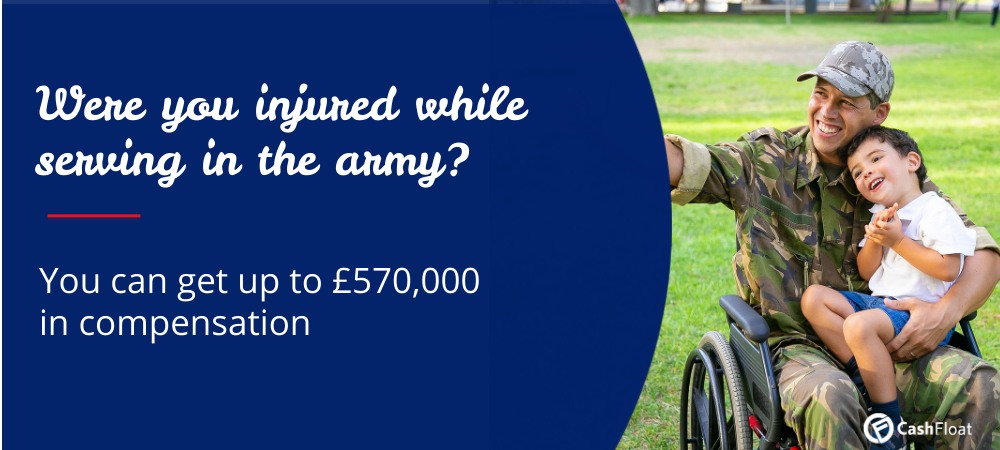
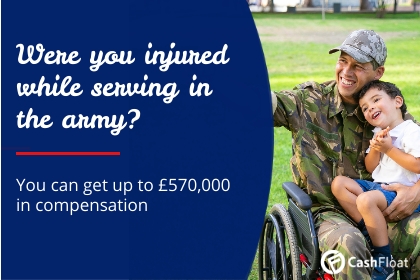
You can apply for the Armed Forces Compensation Scheme by downloading, completing and posting the AFCS Scheme Application Form. If you can’t download the form, you can contact Veterans UK at veterans-uk@mod.gov.uk. Alternatively, you can call 0808 1914 218 and they will be able to provide you with one.
How much Will I Receive?Under the scheme payments are provided as either tax-free lump sums or as Guaranteed Income Payments. The Government provide lump sums for isolated injuries or multiple injuries which occur in the same incident. Payments range from £1,200 to £570,000 for lump sums. Guaranteed Income Payments are generally provided to the more seriously affected people and are also tax-free. Guaranteed Income Payments are received for life and they calculate the amount on a case by case basis.
Blind Person’s Allowance
Blind Person’s Allowance is a benefit provided to people, in England and Wales, who are registered with their local council or have a recognised certificate to say that they are blind or severely sight impaired. In Scotland and Northern Ireland, they need to either have a recognised certificate to say that they are blind or severely sight impaired, or to be able to prove that they are unable to do work for which eyesight is essential.
Under Blind Person’s Allowance, an extra amount is added on top of a person’s tax-free allowance. A tax-free allowance is the amount that a person can earn before they have to pay tax. The current standard tax-free Personal Allowance is £12,500. Most people receive the standard allowance.
People who receive Blind Person’s Allowance will have another £2,500 on top of their standard tax-free Personal Allowance. To claim contact HM Revenue and Customs on 0300 200 3301.
Reduced Earnings Allowances
Most people can no longer claim for Reduced Earnings Allowances as it is only applicable to a work-related injury or disease which occurred before October 1990. However, people who did suffer an illness or disability at work before that date can claim up to £72.80 per week. This is only if their illness or disability means that they can’t return to work.
Summary: Disability Benefits UKIn this article we have tried to explain exactly how and when you can claim disability benefits in the UK. Don’t forget that there are other disability benefits available in the UK. If your disability affects your ability to work, or if you are unemployed and you haven’t found what you need in this section, then you can read more about disability benefits in the UK in the first half of this chapter: Disability Benefits – Guide to all benefits for the disabled.


